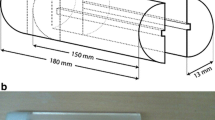Abstract
Accuracy of dwell position and reproducibility of dwell time are critical in high dose rate (HDR) brachytherapy. A phantom was designed to verify dwell position and dwell time reproducibility for an Ir-192 HDR stepping source using Computed Radiography (CR). The central part of the phantom, incorporating thin alternating strips of lead and acrylic, was used to measure dwell positions. The outer part of the phantom features recesses containing different absorber materials (lead, aluminium, acrylic and polystyrene foam), and was used for determining reproducibility of dwell times. Dwell position errors of <1 mm were easily detectable using the phantom. The effect of bending a transfer tube was studied with this phantom and no change of clinical significance was observed when varying the curvature of the transfer tube in typical clinical scenarios. Changes of dwell time as low as 0.1 s, the minimum dwell time of the treatment unit, could be detected by choosing dwell times over the four materials that produce identical exposure at the CR detector.




Similar content being viewed by others
References
Houdek PV, Schwade JG, Wu X, Pisciotta V, Fiedler JA, Serago CF, Markoe AM, Abitbol AA, Lewin AA, Braunschweiger PG, Marshall DS (1992) Dose determination in high dose-rate brachytherapy. Int J Radiat Oncol Biol Phys 24:795–801
DeWerd LA, Jursinic P, Kitchen R, Thomadsen BR (1995) Quality assurance tool for high dose rate brachytherapy. Med Phys 22:435–440
Schaetzing R, Whiting BR, Lubinsky AR, Owen JF (1990) Digital radiography using storage phosphors. In: Digital imaging in diagnostic radiology, Churchill Livingston, New York, pp 107–138
Sonoda M, Takano M, Miyahara J, Kato H (1983) Computed radiography utilizing scanning laser stimulated luminescence. Radiology 148:833–838
Rowlands JA (2002) The physics of computed radiography. Phys Med Biol 47:R123–R166
Samei E, Seibert JA, Willis CE, Flynn MJ, Mah E, Junck KL (2001) Performance evaluation of computed radiography systems. Med Phys 28:361–371
Kutcher GJ, Coia L, Gillin M, Hanson WF, Leibel S, Morton RJ, Palta JR, Purdy JA, Reinstein LE, Svensson GK, Weller M, Wingfield L (1994) Comprehensive QA for radiation oncology: Report of the AAPM Radiation Therapy Committee Task Group 40. Med Phys 21:581–618
Klein EE, Hanley J, Bayouth J, Yin FF, Simon W, Dresser S, Serago C, Aguirre F, Ma L, Arjomandy B, Liu C, Sandin C, Holmes T (2009) Task group 142 report: quality assurance of medical accelerators. Med Phys 36:4197–4212
Author information
Authors and Affiliations
Corresponding author
Rights and permissions
About this article
Cite this article
Madebo, M., Pillainayagam, J., Kron, T. et al. A phantom for verification of dwell position and time of a high dose rate brachytherapy source. Australas Phys Eng Sci Med 35, 335–339 (2012). https://doi.org/10.1007/s13246-012-0138-0
Received:
Accepted:
Published:
Issue Date:
DOI: https://doi.org/10.1007/s13246-012-0138-0




